What is a Decimal Point?
A Decimal Point can be defined as a point or a dot which is used to separate a whole number from the fractional part of a number. It is also known as Decimal Mark. The symbol of decimal point is (.). We use decimals in our daily life as well. For example: If the cost of a shirt is $\$$10 and 50 cents, we can write it as $\$$10.50.
Recommended Games
More about Decimal Point
A decimal number is a number that consists of a whole number and a fractional part separated by a point. For example – 3.5, 6.79, 78.32 etc
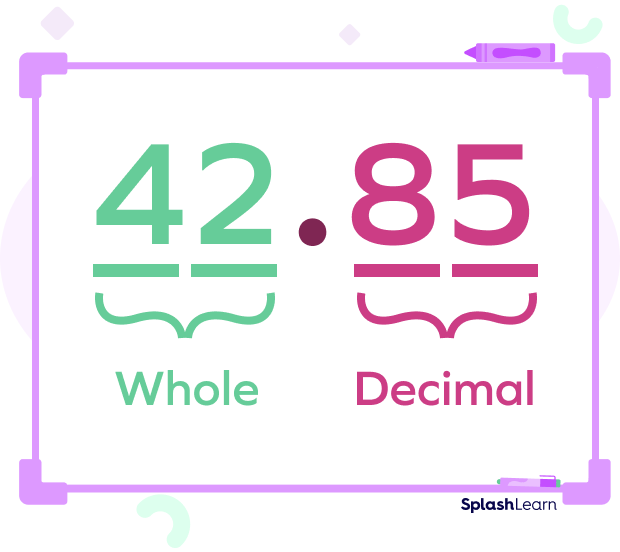
In the figure given above, the decimal point separates the whole number 42 from the fractional part $\frac{85}{100}$. In words, it is written as Forty Two Point Eight Five.
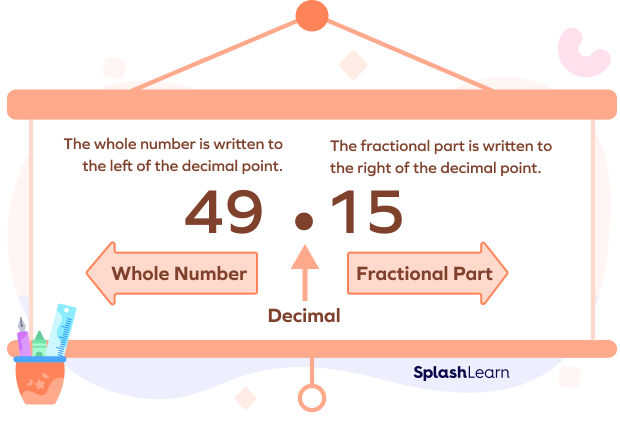
Let us take the example shown in the image above.
The whole number is on the left side of the decimal point and the fractional part is on the right side of the decimal point.
The decimal point makes it simple to read a decimal number.
- Using “and” in place of the decimal point:
In this method:
- The whole number part is read as is.
- The decimal point is read as “and”.
- Then the fractional part is read as per it’s place value. You will learn about this in the next subtopic.
For example, the number 258.16 is read as “two hundred fifty-eight and sixteen hundredths”.
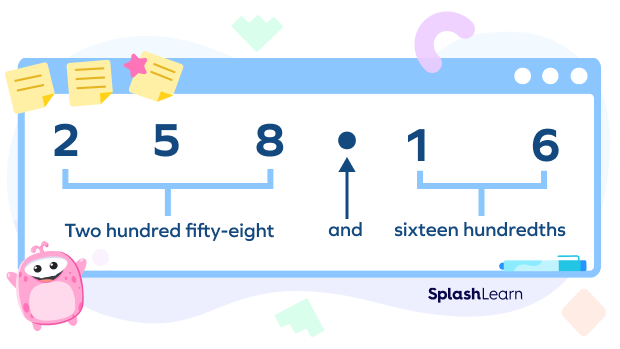
- Reading the decimal as “point”:
In this method:
- The whole number part is read as is.
- The decimal point is read as “point”.
- Then the fractional part is read as individual digits.
For example, the number 258.16 is read as “two hundred fifty-eight point one six”
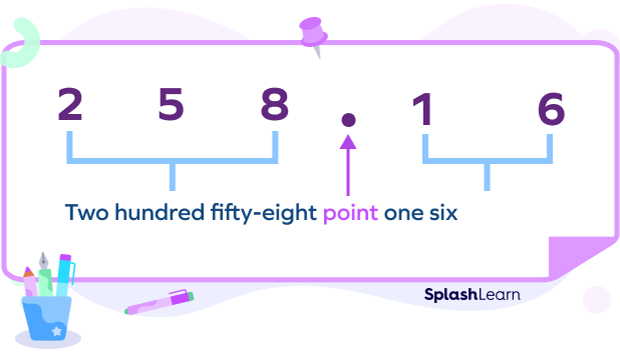
Recommended Worksheets
Decimal Place Value Chart
Before the decimal point, the place value system is the same as the whole number. But talking about after the decimal point, everything changes.
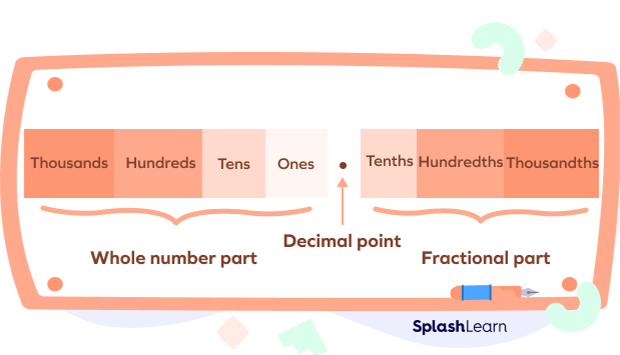
Tenths is $\frac{1}{10}$.
Hundredths is $\frac{1}{100}$.
Thousandths is $\frac{1}{1000}$.
The decimal point is given between ones and tenths.
Moving Decimal Point to Right
In order to move the decimal point from left to right, we multiply the number by 10.
Let us understand it through an example.
$243. 756\times10 = \frac{243756}{1000}\times10 = 2437. 56$
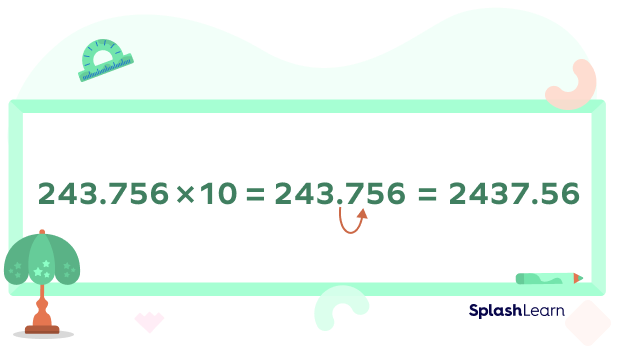
In the above image, the point is before 7. As we multiply the decimal number 243. 756 by 10, the decimal point shifts one place to the right and comes before 5.
What if we multiply 243. 756 by 100?
The decimal point shifts to two places on the right and it will come after 5 and the new decimal number will be 24375. 6
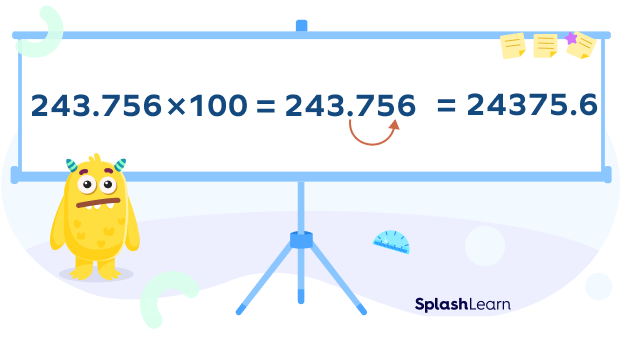
General Rule: From the above, we conclude that the decimal will be moved to the right by as many places as the number of zeroes in the multiplier and when the number of zeros are given to be more than the digits after the decimal number, then extra zeros must be added to the product.
For example: $92. 89\times1000 = 92890$
Moving Decimal Point to Left
In order to move the decimal point from right to left, we divide the number by 10.
Let us understand it through an example.
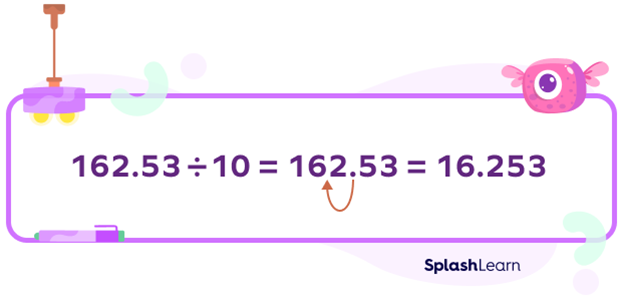
$162. 53\div10 = \frac{16253}{100}\times\frac{1}{10} = \frac{16253}{1000} = 16. 253$
What if we divide 162. 53 by 100?
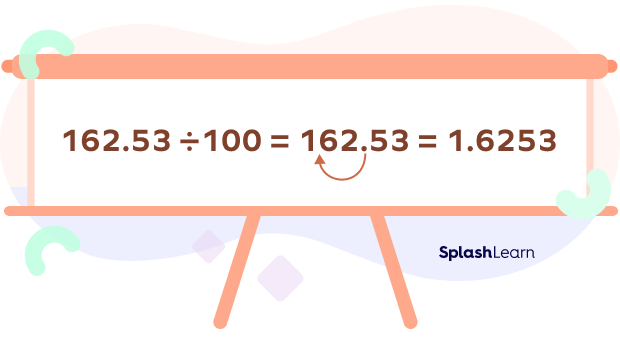
The decimal point shifts to two places on the left and it will come after 1 and the new decimal number will be 1. 6253.
General Rule: From the above, we conclude that the decimal will be moved to the left by as many places as the number of zeroes in the divisor and when the number of zeros is given to be more than the digits before the decimal number, then extra zeros must be added in front of the number.
For example: $92. 89\div1000 = 0. 09289$
Fun Facts
- The fractional part to the right of the decimal point denotes a number less than 1.
- A whole or natural number can also be represented as a decimal number by simply writing point zero ( .0) after the one’s digit. For example, we can write 15 can as 15.0.
Conclusion
To conclude from the above-explained, the decimal point separates the whole part and the fractional part. If you are looking for some more worksheets on the decimal point, check out SplashLearn today! Visit the website to make learning a fun experience.
Solved Examples on Decimal Point
- What is a decimal point?
A decimal point is the point or dot which is used to separate the whole part and the fractional part of a number. The symbol of decimal point is (.).
- Simplify $67. 78 \times10$.
On multiplying by 10, the decimal point moves one place to the right. We get 677. 8.
- Simplify $675. 29 \div100$.
On dividing by 100, the decimal point moves two places to the left. We get 6. 7529.
Practice Problems on Decimal Point
Decimal Point - Definition With Examples
By what number should we multiply so that the decimal point moves two places to the right?
We multiply by 100 to shift the decimal point two places to the right.
By what number should we divide so that the decimal point moves one place to the left?
We divide by 10 to shift the decimal point one place to the left.
Solve $89. 9\times100$.
When we multiply a decimal number by 100, the decimal point will shift to two places to the right. So, a zero will be added and
the number will be 8990.
$\frac{899}{10}\times100 = 8990$
Frequently Asked Questions on Decimal Point
What is the other name of decimal point?
The decimal point is also known as decimal marker or decimal separator.
What are the different symbols for the decimal separator?
In most English-speaking countries, the decimal point is usually denoted by a period/dot (.) to separate the whole number from its fractional parts. However, in continental Europe, the decimal point is usually denoted with the comma (,).
What is the purpose of the decimal point?
The decimal point is used to separate the whole number and fractional part of a number.




































